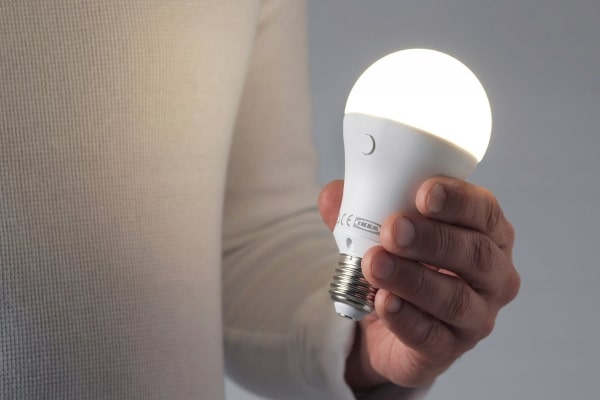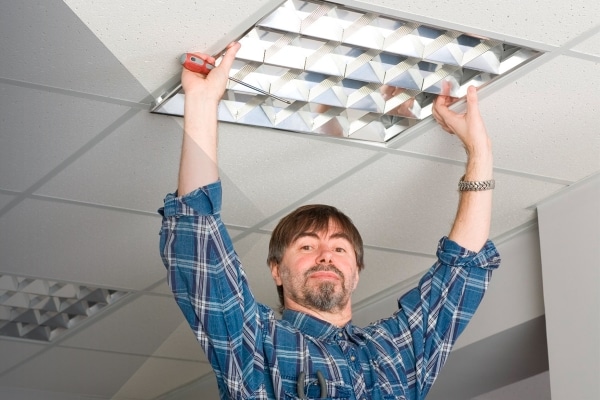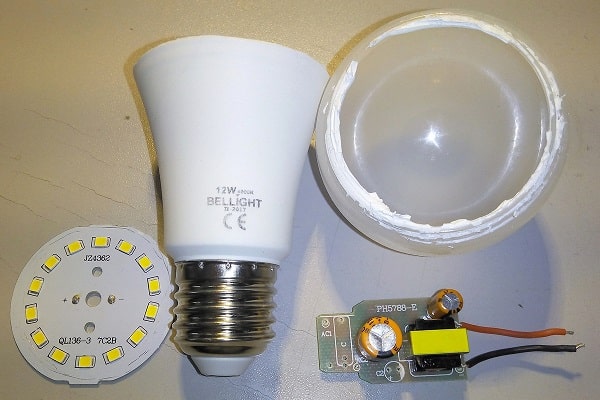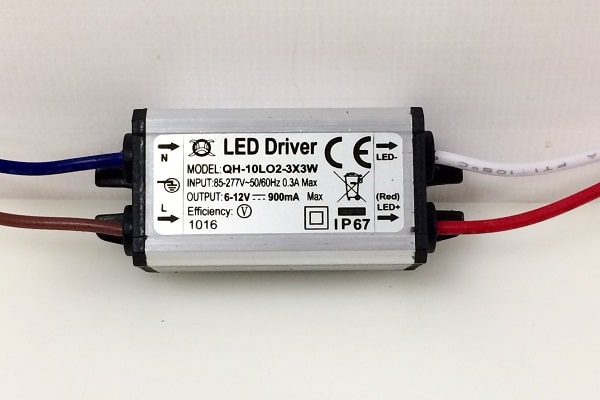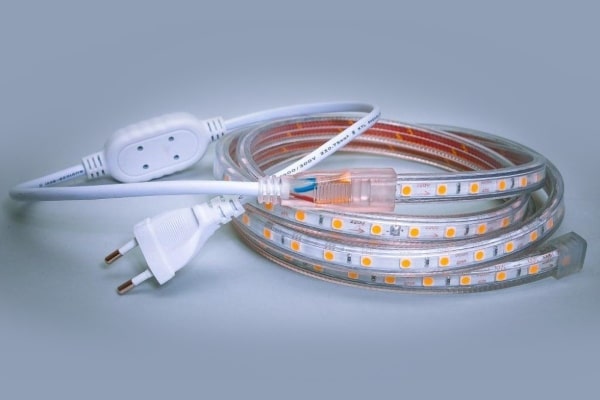With the development of electrical engineering, the traditional incandescent lamp is no longer the only option for home lighting. 12V LED lamps have gained great popularity among consumers. Due to their high energy efficiency and reliability, they have replaced classic appliances.
The device and principle of operation of LED lamps
Light-emitting diode (LED) lamps operate at a voltage of 12 V and have several components that are interconnected in one housing.
Consider the main elements:
- Plinth. It is screwed into the socket of a chandelier or other lamp. Most often, for domestic use, a screw base of the E27 and E14 types is produced. They are made mainly of brass, with a nickel-plated anti-corrosion coating.
- Driver. An element that stabilizes the incoming voltage. Converts AC to DC to power the LED.
- Radiator. A component that creates an acceptable operating temperature for LEDs. The most common are aluminum and composite, they are quite budgetary and efficiently remove heat.
- Diffuser. A transparent “hood” that helps to separate the light in space. Produced in the form of a hemisphere to scatter light at a wide angle. The material used is polycarbonate or plastic. The diffuser prevents dust and moisture from entering the housing.
- LEDs. The main working component of the lamp. Due to the operation of the diode, lighting appears.
LED lamp device: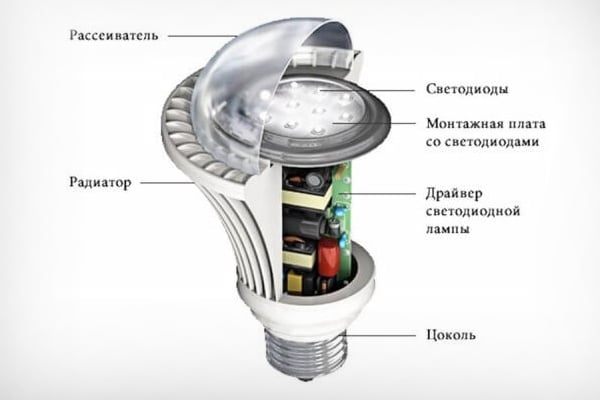
The mechanism of operation is based on physical processes in semiconductors. The glow appears after the passage of an electric current through the boundary of the connection of two semiconductors, one of which should be dominated by electrons that are negatively charged, and the other by positively charged ions.
As a result, light is visible to the eye. In addition to the glow, there is also a release of heat, which is removed from the LED using a radiator.
Specifications of 12V LED bulbs
There are many technical and operational features of 12 V lamps. List of the main ones:
- Colorful temperature. Its performance is in the range of 2700–6500 K. When the lamp is operating, cold (white) or warm (yellow) light predominates.
- Durability. The average life of lighting fixtures is 50,000 hours.
- Power. This indicator is necessary to calculate the total use of lighting in a room or building as a whole. For all types of LED lamps, the power consumption varies from 3 to 25 watts.
- Availability of a driver. As a rule, manufacturers make LED lamps with a large amount of voltage – for example, 150-250 V. Therefore, such devices are not dangerous for major voltage drops.
- Direction of light flow. The LED itself can only direct radiation in one direction. If the lighting device must illuminate everything around evenly, for this it is necessary to place a diffuser made of frosted polycarbonate in front of the LED.
- Ability to adjust brightness. To control the level of illumination, a dimmer is used (a device that generates power in the form of pulses). According to the pulse frequency, the light burns dimmer or brighter.
Types of LED lamps and their bases
By design, LED light sources are divided into several types. They are the following:
- general purpose devices – used for lighting industrial buildings, and in living space;
- LED lamps with oriented light – placed in appliances, used to illuminate parts of buildings and the landscape;
- linear lamps – they have a similar base with fluorescent ones, which allows you to immediately replace one light source with another.
When connecting LED sources to an electric line with a voltage of 220 V, they must be powered by a power supply, which is selected taking into account the purpose of the fixtures.
Types of power supplies:
- Sealed – used to install lamps in the bathroom, sauna, as street lighting.
- Leaky – designed for installation indoors with a normal humidity indicator.
- With active cooling – equipped with a fan to increase power and reduce size.
- Passive cooling – a heatsink is used to remove heat.
The main characteristics of power supplies:
- Power.
- output current.
- Output voltage.
In order for LED light sources to fit the already used power supply scheme of houses, they are equipped with screw bases. As an alternative to halogen lamps, lamps with pin bases are produced.
The main types of plinths are presented in the table:
Colorful temperature
In the glow of LED light sources, either the blue wavelength or red with yellow predominates. For this reason, they are divided into cold and warm, respectively.
Color temperature has a wide range:
- up to 2800 K – warm yellow light with a red tint;
- 3000 K – warm white light with yellow;
- 3500 K – natural neutral white light;
- 4000 K – cold white;
- 5000-6000 K – daylight;
- 6500 K and above – cold daytime with a bluish tint.
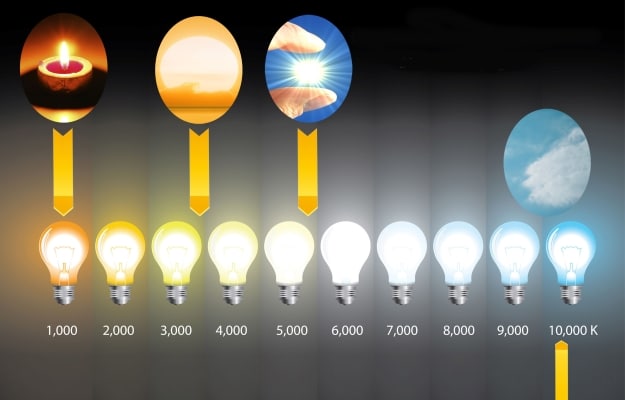
Power and operating voltage
Studying the functional properties on the product packaging, the majority focuses on the values of power consumption and operating voltage.
The power indicator is important when calculating the total electricity consumption. LED lamps are produced with different power, in accordance with their purpose. For example, from 3 to 20 watts is enough for a house, more energy-intensive lamps, about 25 watts, are needed to illuminate the street.
Another important indicator is the operating voltage. The current source can be constant or variable, but the voltage of the LEDs needs a constant – 12 V. The driver is responsible for their work, which converts it in the network to the required indicator.
Where are 12V LED lights used?
Due to the low supply voltage and the large number of base types, 12 volt LED bulbs are universal. They can be used for:
- general lighting (12 volt LEDs for chandeliers), including those built into stretch ceilings (LED ceiling lights);
- decorative lighting – external and internal (spotlights).
Automotive LED bulbs are a separate category, which can be installed in almost all vehicle lighting fixtures. The 12v LED lamp is also designed for cornices, furniture, shop windows, fountains, garden paths, flower beds. Easily integrated into structures:
- panels;
- billboards;
- signboards.
Low-voltage power provides devices with increased electrical and fire safety, which allows them to be used in the following rooms:
- kitchens;
- bathrooms;
- saunas;
- pools, including for underwater lighting;
- warehouses;
- basements;
- outdoors without special protection measures and wiring with increased insulation.
Wiring diagram for 12 V lamps
The connection is similar to incandescent and fluorescent lamps – you should de-energize the cartridge and screw the lamp into it. If you need to connect several LED light sources, then two connection options are possible: serial and parallel.
serial connection
Requires a minimum number of wires, but is rarely used. The reason for this is the following shortcomings:
- when one bulb burns out, the entire circuit fails;
- the lamps do not work at full strength, since when connected in series, the voltage is summed up.
The scheme is quite simple:
- Lead the phase from the junction box to the switch.
- From the switch, stretch the phase to the LED lamp.
- Connect the neutral wire to the second contact of the last lamp in the circuit.
- Pull the phase wire from the lamps to each other.
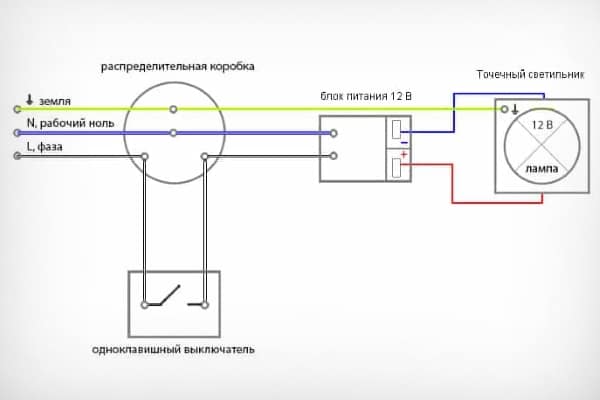
Parallel connection
The main advantage is that the same voltage is applied to all the bulbs in the circuit. In the event of a burnout, only a failed light source drops out of the circuit, which is easy to replace.
It is important to consider the moment of connection of all elements. Most often, a terminal block is used for this. On the one hand, a phase is supplied to its jumpers, on the reverse side, wires are connected, stretching from the light bulbs.
Wiring diagram:
Advantages and disadvantages
To switch to lighting devices that are connected to a low-voltage power source, you should study their advantages and disadvantages. Among the advantages are the following:
- Safety. The use of LED lamps in 12V fixtures increases the level of protection and eliminates the possibility of electric shock.
- Fire safety. Low-voltage wiring cannot be a source of ignition and cause a fire.
- Saving. When using this light source for the room, the consumption of electricity and, accordingly, the cost of money to pay bills are reduced.
- Environmental friendliness. The designs do not use materials that, during the operation of the device, emit harmful substances to human or animal health.
- Reliability. The lamps are highly resistant to mechanical damage: scratches, chips, etc.
The disadvantages of LED lamps designed for 12V include:
- The need for a power supply unit (PSU). The presence of a driver that stabilizes and lowers the mains voltage from 220 to 12 V complicates wiring, reduces lighting efficiency, and due to it an additional weak link appears in the circuit, which can fail.
- Glow brightness. The power of the luminous flux of a lampconnected to a low-voltage network is affected by the voltage drop. This is due to the consumption of more current.
Properly selected LED light source will work for a long time. Now the main disadvantage of lamps is their high cost, but with the development and improvement of technology, they will become publicly available to all buyers.
12 volt LED lamps can be called the most acceptable option for the consumer. They have all the necessary qualities for successful and efficient operation for a long time. Manufacturers provide a wide range, allowing everyone to choose the best option for themselves.


